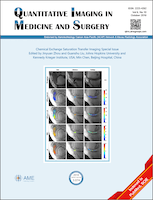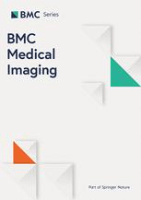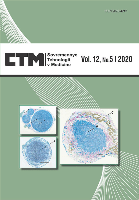
Diagnostics
Scope & Guideline
Shaping the Future of Diagnostic Techniques
Introduction
Aims and Scopes
- Advanced Imaging Techniques:
Research on the development and application of imaging modalities such as MRI, CT, and ultrasound, focusing on their role in diagnosing various conditions, including cancers and cardiovascular diseases. - Artificial Intelligence in Diagnostics:
Exploration of machine learning and AI applications in enhancing diagnostic processes, automating image analysis, and improving predictive modeling for disease outcomes. - Biomarker Discovery and Validation:
Studies aimed at identifying and validating biomarkers for various diseases, including cancer, autoimmune disorders, and infectious diseases, to facilitate early detection and treatment monitoring. - Clinical Decision Support Systems:
Development of systems that integrate clinical data and diagnostic imaging to aid healthcare professionals in making informed decisions regarding patient care. - Systematic Reviews and Meta-Analyses:
Comprehensive assessments of existing literature to synthesize findings on diagnostic accuracy, efficacy of diagnostic tools, and emerging trends in the field.
Trending and Emerging
- Telemedicine and Remote Diagnostics:
The COVID-19 pandemic has accelerated research in telemedicine, focusing on remote diagnostic tools and point-of-care testing, enabling healthcare delivery in various settings. - Integration of Multi-Omics Approaches:
Emerging studies are increasingly incorporating genomic, proteomic, and metabolomic data to enhance diagnostic accuracy and provide comprehensive patient insights. - AI and Machine Learning Innovations:
There is a growing body of research applying AI and machine learning techniques to improve diagnostic imaging, predict disease progression, and automate analysis, highlighting their transformative potential. - Liquid Biopsy Technologies:
Research focusing on non-invasive liquid biopsy methods for cancer diagnosis and monitoring is gaining momentum, reflecting a shift towards less invasive and more patient-friendly diagnostic approaches. - Patient-Centered Diagnostic Approaches:
There is an increasing emphasis on patient-reported outcomes and personalized diagnostics, aiming to tailor diagnostic processes to individual patient needs and conditions.
Declining or Waning
- Traditional Diagnostic Methods:
There is a noticeable decrease in publications focusing solely on traditional diagnostic methods, such as basic laboratory tests, as newer technologies and AI-driven approaches gain traction. - Invasive Diagnostic Procedures:
Research on invasive procedures like biopsies or exploratory surgeries has diminished, likely due to the increased reliance on non-invasive imaging techniques and liquid biopsies. - Single Disease Focus Studies:
The trend has shifted from studies that focus on single diseases to more integrative approaches that consider multi-disease or multi-factorial perspectives in diagnostics. - Basic Biomarker Studies:
Research on basic biomarkers without advanced validation or integration into clinical pathways is declining as emphasis grows on comprehensive biomarker panels and multi-omics approaches.
Similar Journals

Quantitative Imaging in Medicine and Surgery
Elevating Medical Imaging: Bridging Research and PracticeQuantitative Imaging in Medicine and Surgery is an esteemed journal dedicated to advancing the field of medical imaging through rigorous research and innovative methodologies. Published by AME PUBLISHING COMPANY in China, this journal has established itself with an impressive Q2 quartile ranking in the field of Radiology, Nuclear Medicine, and Imaging, reflecting its dedication to high-quality research. With a comprehensive focus on quantitative imaging techniques, the journal covers a wide range of topics including image analysis, imaging biomarkers, and the integration of imaging in clinical practice, promoting collaboration between imaging specialists and clinicians. As an open access journal, Quantitative Imaging in Medicine and Surgery ensures that its articles are freely accessible, facilitating the dissemination of knowledge to a broader audience. With a commitment to fostering innovation in imaging science, this journal serves as an invaluable resource for researchers, professionals, and students alike, ultimately aiming to improve patient outcomes through advanced imaging strategies and technologies.

Journal of Cardiovascular Medicine
Empowering Clinicians with Cutting-Edge Cardiovascular ResearchWelcome to the Journal of Cardiovascular Medicine, a leading platform for the dissemination of high-quality research in the field of cardiology and cardiovascular medicine. Published by Lippincott Williams & Wilkins, this esteemed journal boasts an ISSN of 1558-2027 and an E-ISSN of 1558-2035, reflecting its commitment to accessible and innovative cardiovascular research. With a significant impact factor and ranked Q2 in both Cardiology and Cardiovascular Medicine as well as in Medicine (Miscellaneous) for 2023, the journal is recognized for its contributions to advancing knowledge and practice in this critical area of health. The journal disseminates original research, reviews, and clinical studies, aimed at clinicians, researchers, and healthcare professionals who are dedicated to improving cardiovascular health outcomes. With a continuous commitment to evolving research from 2006 to 2024, the journal is an essential resource for those looking to stay at the forefront of the latest discoveries and methodologies in cardiovascular medicine.

INTERNATIONAL JOURNAL OF CARDIOVASCULAR IMAGING
Elevating Standards in Cardiovascular Imaging ResearchINTERNATIONAL JOURNAL OF CARDIOVASCULAR IMAGING, published by Springer, is a prestigious platform dedicated to the interdisciplinary field of cardiovascular medicine and imaging. With an ISSN of 1569-5794 and E-ISSN 1875-8312, the journal is recognized in both Cardiology and Cardiovascular Medicine (Rank #154/387, Q2 Category) and Radiology, Nuclear Medicine and Imaging (Rank #137/333, Q2 Category) disciplines, reflecting its significant impact within the scientific community. Established in 1988 and continuing to the present, it provides a rigorous forum for cutting-edge research, reviews, and clinical insights that are essential for advancing knowledge in cardiovascular diagnostics and therapeutic imaging. The journal's dual access options cater to both traditional and open-access readership, ensuring wide dissemination of its findings. In an era where cardiovascular diseases pose a significant public health challenge, the INTERNATIONAL JOURNAL OF CARDIOVASCULAR IMAGING stands out as an essential resource for researchers, healthcare professionals, and scholars aiming to innovate and improve patient outcomes through imaging technology.

EUROPEAN JOURNAL OF NUCLEAR MEDICINE AND MOLECULAR IMAGING
Connecting Researchers to Transformative Medical InsightsThe European Journal of Nuclear Medicine and Molecular Imaging is a prestigious, peer-reviewed journal published by Springer, dedicated to advancing the field of nuclear medicine and molecular imaging. With an impressive impact factor and ranked in the Q1 category for both Medicine and Radiology, Nuclear Medicine and Imaging, this journal is a pivotal platform for researchers and practitioners to disseminate significant findings from 1996 to the present, reflecting the evolution of the field. The journal boasts a notable Scopus rank, standing at #8 out of 333 in its category, placing it in the top 3% of published works, which highlights its critical importance in shaping contemporary practices and research innovations. Although it does not offer an open-access model, the journal provides various access options to ensure that important research is accessible to professionals, students, and academics alike. Through rigorous peer review and a commitment to high-quality publication, the European Journal of Nuclear Medicine and Molecular Imaging plays an essential role in the advancement of nuclear medicine, contributing to better diagnostic and therapeutic outcomes globally.

CANCER CYTOPATHOLOGY
Illuminating the Path to Better Cancer ManagementCancer Cytopathology, published by Wiley, is an esteemed journal that plays a pivotal role in the fields of Cancer Research and Oncology. With a focus on the microscopic examination and analysis of cancerous cells, this journal serves as a crucial platform for disseminating high-quality research aimed at improving diagnostic techniques and therapeutic strategies. The journal holds an impressive Q2 ranking in both Cancer Research and Oncology as of 2023, emphasizing its influence and importance within the scientific community. Additionally, it is recognized in the top 76th percentile in Medicine - Oncology and the 63rd percentile in Cancer Research according to Scopus rankings. Operating from the United States, Cancer Cytopathology is dedicated to fostering cutting-edge research and exploration in cytopathology, providing essential insights into cancer progression and management. Researchers and practitioners alike will find this journal invaluable for staying on the forefront of advancements in cancer diagnostics.

Emergency Radiology
Transforming Emergency Medicine Through Radiology InsightsEmergency Radiology, published by SPRINGER HEIDELBERG, is a leading journal in the fields of emergency medicine and radiology, dedicated to advancing the understanding and application of diagnostic imaging in urgent medical conditions. Established in 1994, this journal has consistently contributed to the discourse around emergency diagnostics, maintaining a strong position within the academic community, as evidenced by its Q2 rankings in both Emergency Medicine and Radiology, Nuclear Medicine and Imaging categories as of 2023. With a distinguished focus on innovative research and case studies, it serves a diverse audience of researchers, clinicians, and healthcare professionals who seek to enhance their knowledge and improve patient outcomes in emergency settings. While the journal is not currently open access, it offers robust subscription options and continues to be an integral resource for those at the forefront of emergency care. With an ISSN of 1070-3004 and an E-ISSN of 1438-1435, Emergency Radiology is positioned to remain a key player in shaping the future of medical imaging through its commitment to high-quality research and evidence-based practices.

BMC MEDICAL IMAGING
Advancing the Future of Radiology and Imaging Technologies.BMC Medical Imaging is a premier open-access journal dedicated to advancing the field of radiology, nuclear medicine, and imaging technologies. Published by BMC in the United Kingdom, this journal serves as a vital resource for researchers, clinicians, and students, fostering a collaborative environment for sharing innovative findings and methodologies in medical imaging. With a commendable impact factor and an impressive Scopus ranking within the top 35% of its category, BMC Medical Imaging provides a platform for high-quality research to be disseminated widely and freely since its inception in 2001. The journal aims to cover a diverse array of topics, from advanced imaging techniques to their clinical applications, enhancing the understanding and effectiveness of diagnostic practices. By contributing to the body of knowledge and facilitating open access to research, BMC Medical Imaging plays a pivotal role in shaping the future of medical imaging and improving patient care.

International Journal of Clinical and Experimental Pathology
Unlocking the Secrets of Pathology for AllInternational Journal of Clinical and Experimental Pathology, published by E-CENTURY PUBLISHING CORP, serves as a vital resource for professionals in the field of pathology. With its ISSN 1936-2625, the journal has positioned itself within the competitive landscape of medical journals, achieving commendable rankings in Scopus, particularly in the categories of Pathology and Forensic Medicine (Rank #98/185) and Histology (Rank #38/58). Although its coverage in Scopus has been discontinued, the journal’s past contributions from 2009 to 2017 continue to be a touchstone for researchers interested in advancing their understanding of clinical and experimental pathology. The open-access format ensures accessibility to a wide audience, fostering collaboration and education in this essential medical discipline. By bridging clinical research and experimental findings, this journal plays a crucial role in disseminating knowledge and enhancing practices within pathology, making it an indispensable tool for researchers, professionals, and students alike.

Sovremennye Tehnologii v Medicine
Unlocking New Frontiers in Medical ScienceSovremennye Tehnologii v Medicine is a prominent academic journal dedicated to the exploration and dissemination of contemporary technologies in the field of medicine. Published by the esteemed Nizhniy Novgorod State Medical Academy, this journal serves as a vital platform for researchers, healthcare professionals, and students seeking to stay at the forefront of advancements in biochemistry, genetics, and molecular biology. With an impact factor that positions it within the Q3 quartile for both Biochemistry, Genetics and Molecular Biology and Medicine categories as of 2023, it highlights a commitment to quality research. The journal, identified by the ISSN 2076-4243, provides a rich repository of knowledge for those interested in the innovative applications of medical science, contributing significantly to the academic discourse and the practical world of healthcare. With an open access option, it ensures that its valuable content is readily accessible to a global audience, fostering collaborative advancements in modern medical practices.

Tomography
Elevating the standards of medical imaging research.Tomography is an esteemed peer-reviewed journal published by MDPI, focusing on a broad spectrum of topics related to medical imaging and diagnostics. Launched in 2015, this Open Access journal serves as a vital platform for researchers, professionals, and students in the fields of medicine, radiology, nuclear medicine, and imaging. With an impressive impact factor reflecting its relevance, the journal has achieved a quartile ranking of Q2 in both Medicine (Miscellaneous) and Radiology, Nuclear Medicine, and Imaging as of 2023. Renowned for disseminating high-quality research, Tomography welcomes original research articles, reviews, and technical notes, fostering innovation and collaboration within the scientific community. Housed in Basel, Switzerland, the journal aims to bridge the gap between fundamental research and clinical application, appealing to a diverse readership eager to advance the field of medical imaging.